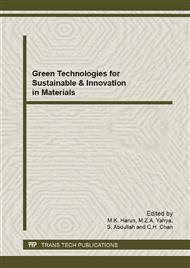p.250
p.261
p.266
p.275
p.280
p.285
p.290
p.296
p.305
Fabrication and Characterization of Ceramic Membrane by Gel Cast Technique for Water Filtration
Abstract:
Sayong ball clay membrane can be fabricated without the assistance of high-tech sophisticated machineries and complicated production methods make the filters particularly attractive as a point-of-use treatment. This work was concerned with the study of Sayong ball clay membrane as a water filtration by Gel Cast technique. Gel cast involves mixing process of Sayong ball clay with the solvent, monomer, dispersant, initiator and catalyst in a certain composition Tubular membrane was designed and fabricated by controlling the Gel Cast monomer (5, 10, 15, 20 MAM percentage) at sintering temperature of 1300°C. The physical measurements (shrinkage, apparent porosity, bulk density), microstructure analysis, filtration process (flow rate) and water quality assessments (pH, color, COD, SS) were carried out at different percentage of MAM. The porosity and density of membranes were measured by using Archimedes method. The effect of monomer percentage on microstructure of the membranes has been investigated using FESEM. The experimental results showed that the apparent porosity and bulk density of Sayong Ball Clay Gel Cast with 5% MAM and sintered at temperature of 1300°C for 20 minutes were 15.39% and 1.87 g/cm3, respectively. It gives improvement in water quality with the lowest suspended solid (192 mg/L), lowest COD (4 mg/L) and most colorless (1.1 Gardner units) filtered wastewater as compared to others.
Info:
Periodical:
Pages:
280-284
Citation:
Online since:
April 2013
Keywords:
Price:
Сopyright:
© 2013 Trans Tech Publications Ltd. All Rights Reserved
Share:
Citation:



